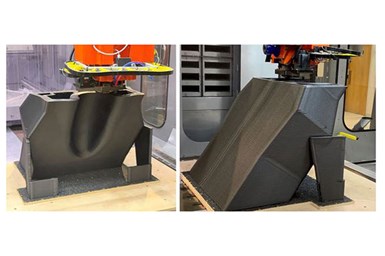Thermwood, Boeing, Navy Collaborate on Large-Scale Composite Tooling Research
Thermwood’s large-scale additive manufacturing (LSAM) machine was selected as the large-format additive manufacturing (LFAM) machine to conduct the technology development.

Composite cure tool printing on Thermwood LSAM.
Thermwood was a development partner in a Navy ManTech-funded program issued to Boeing Research and Technology (BR&T) to validate large-scale, composite additive manufacturing (AM) as a viable method for producing low-cost composite cure tooling technology with substantial time savings over traditional methods.
The program was managed by Advanced Technology International (ATI) for the Office of Naval Research (ONR) with funding provided from the Naval Air Systems Command (NAVAIR) Aircraft Equipment Reliability and Maintainability Improvement Program (AERMIP). Fleet Readiness Center East (FRCE) was a technical contributor. Thermwood’s large-scale additive manufacturing (LSAM) machine was selected as the large-format additive manufacturing (LFAM) machine to conduct the research.
FRCE provided a high-contour mold line surface to Boeing for generating the composite cure tool. The spherically shaped portion of the mold line offered the largest challenge, as the unsupported 3D printed angle limitation of approximately 45 degrees provides an obstacle to overcome for the spherical mold line section of the tool.
Boeing rotated the 3D print plane 35 degrees to avoid encroachment of the build angle limitation. The new build plane approach eliminated the requirement for temporary support material for the aggressive mold line shape. TechmerPM PESU CF 1810 high-temperature print material was used for the composite cure tool. Two interim support features were added to compensate for the center of gravity shift of the print. The LSAM machine performed flawlessly during the composite cure tool print, the company says. The tool was printed in 7 hours and 26 minutes using 610 lbs of material.
The composite cure tool was machined in 53 hours using the LSAM gantry router machine. The tool datum features and removal of interim members were machined prior to removal from the beadboard. The composite cure tool mold line part surface achieved a surface profile tolerance of .020” (+/-.010”).
The LFAM technology cost savings was estimated at 50% compared to traditional tool fabrication methods, and reduced tool fabrication lead time by 65%. The cost savings and tool fabrication cycle time reduction could provide enormous benefit to any organizations performing low-volume or custom composite part fabrication and repair, the group says.
Related Content
-
How a DOD-Funded Resilient Manufacturing Ecosystem (RME) Is Coming Together at Neighborhood 91
Pittsburgh’s additive manufacturing campus doubles as a test bed for a Department of Defense project aimed at developing a reproducible ecosystem for on-demand production of critical parts.
-
America Makes Announces Winners for IMPACT Project Call
The project call focuses on additive manufacturing research related to casting and forging, metal powder sourcing and robotic AM process planning for continuous fiber-reinforced composite structures.
-
DOD Drives Transformation with New AM Policy
The U.S. Department of Defense published DODI 5000.93, a comprehensive plan for implementing additive manufacturing among military services.








.png;maxWidth=300;quality=90)






